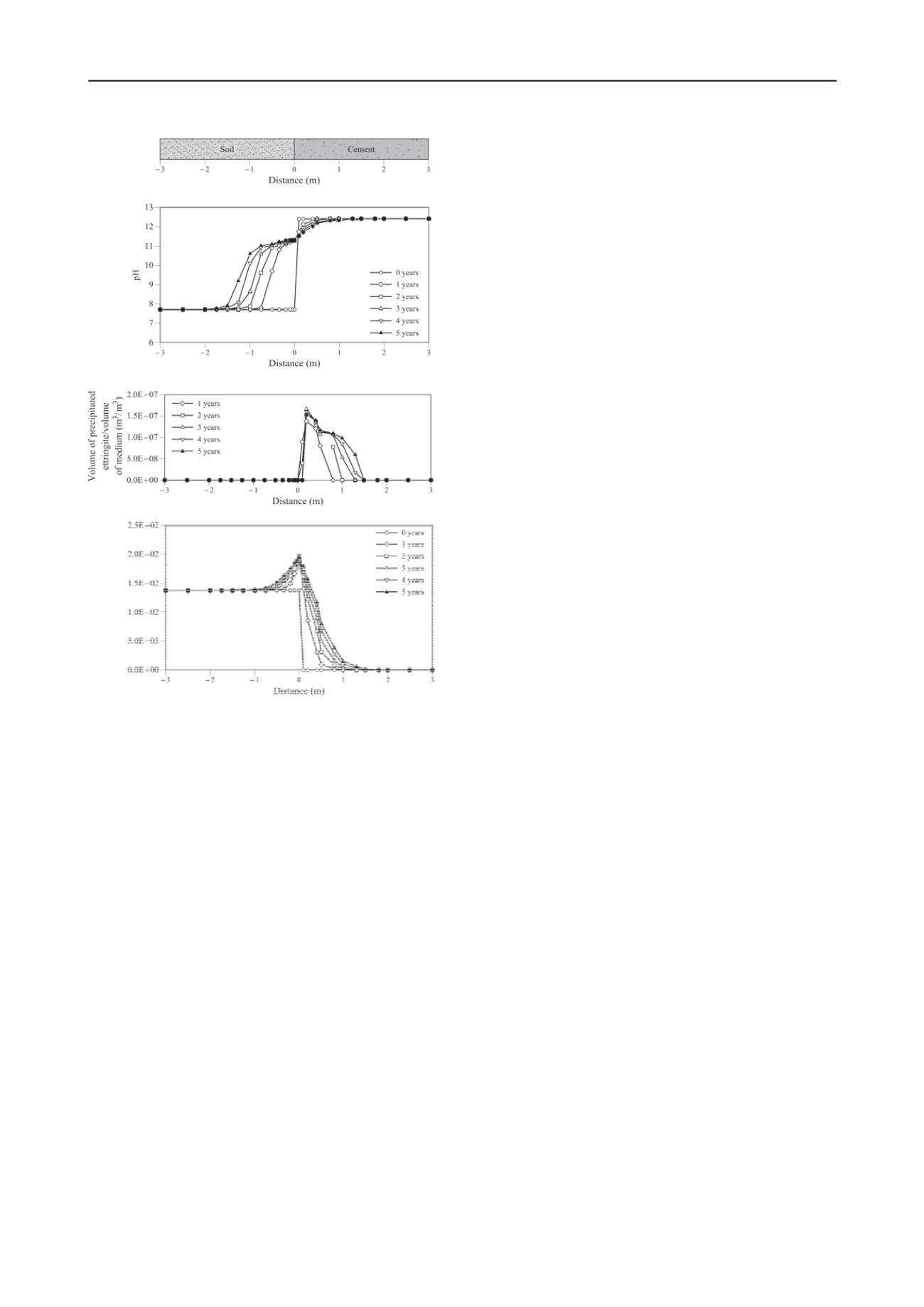
788
Proceedings of the 18
th
International Conference on Soil Mechanics and Geotechnical Engineering, Paris 2013
(a)
(b)
(c)
Moles of SO
4
-2
/kg of water
(d)
Figure 9. Analysis of the soil-cement reactions with the program
RETRASO. (a) Geometry of the problem; (b) Evolution and distribution
of pH; (c) Volumes of ettringite and (d) Concentration of sulphate.
The consequence is the release of Al ions, necessary for
ettringite precipitation. The concentration of sulphate increases
at the interface and immediate vicinity (Fig 9d), which induces
the precipitation of ettringite.
Even if the analysis performed is quantitative, the calculated
volume fraction of precipitates (or dissolved species) is not
believed to be representative. The real problem is exceedingly
complex: the reactive surface is unknown (a small value, 0.14
m
2
/m
3
, was adopted in the calculation model), there are
uncertainties on the validity of the kinetic equations, the pore
water was probably under significant suction values for most of
the time, initial volume fractions and diffusion coefficients were
estimated, etc. Therefore, no attempt was made to couple the
chemical calculations with the observed heave. Nevertheless,
the chemical analysis performed provided a good understanding
of sulphate attack.
5 CONCLUDING REMARKS
The field swelling records suggested that heave of the treated
embankments and above the caisson could continue for years at
a sustained rate. Modifying the thickness of the ballast cushion
below the rail tracks could not cope with the expected medium
term heave. Forces against the abutment wall in the case of the
embankment were damaging the bridge and a passive state of
stress, menacing the rail tracks, had developed in the upper part
of embankments.
It was then decided to excavate the upper 6 m of the
embankments in the stretch affected by sulphate attack. Also, it
was decided to support rail tracks by a structure founded on
piles on both sides of the embankment. Supporting piles
(excavated piles which reach the substratum) were first built.
Once the rail tracks were underpinned, the upper part of the
embankments was excavated in stretches and reinforced
concrete slabs were slid in place. An open gap, 3 m thick, was
left between the lower surface of the slabs and the new upper
surface of the embankments.
The solution of the heave problem above the caisson requires
the removal of the cement treated layer and its substitution by a
stable compacted granular material. This operation will not
impair the circulation of trains.
6 ACKNOWLEDGEMENTS
The authors acknowledge with thanks the technical and
economic support provided by ADIF (National Agency for
Railway Infrastructure). Thanks are also given to contractors
and IIC, for their contribution to the identification and
characterization of the geotechnical conditions of the material,
and to professors E. Vázquez, Dr. M. Barrera and E. Tauler for
their contribution in the identification of minerals.
7 REFERENCES
Alonso, E. and Ramon, A. (2012). Massive attack to cement treated
railway embankments made of compacted sulphated clay.
Géotechnique, in print.
Alonso, E. E. and Ramon, A. (2012). Heave of a railway bridge induced
by gypsum crystal growth. Field observations. Printed online in
Géotechnique.
Alonso, E.E., Berdugo, I.R. and Ramon, A. (2012). Extreme expansive
phenomena in anhydritic-gypsiferous claystones: the case of Lilla
tunnel. Géotechnique, in print.
Mitchell, J.K. & Dermatas, D. (1992). Clay soil heave caused by lime-
sulphate reactions,
ASTM Special Technical Publication,
1135
,
41
64.
Mohamed, A. M. O., 2000. The role of clay minerals in marly soils on
its stability.
Engineering Geology
57
, 193-203.
Puppala, A.J., Wattanasanticharoen, E. & Punthutaecha, K. (2003).
Experimental evaluations of stabilisation methods for sulphate-rich
expansive soils.
Ground Improvement
,
7
, No.1, 25
35.
Rajasekaran, G., (2005). Sulphate attack and ettringite formation in the
lime and cement stabilized marine clays.
Ocean Engineering
,
32
,
1133
1159.
Saaltink, M., I., Ayora, C. & Olivella, S. (2005).
User’s guide for
RetrasoCodeBright (RCB)
. Departament of Geotechnical
Engineering and Geo-Sciences, Technical University of Catalonia.
Institute of Earth Sciences Jauma Almera, Spanish Research
Council (CSIC), Barcelona. 111 p.
Sherwood, P.T. (1962). Effect of sulphates on cement and lime
stabilized soils.
HRB Bull.,
353
, 98
107.


